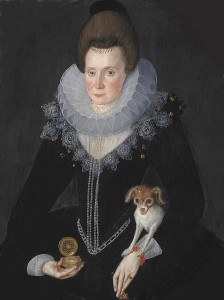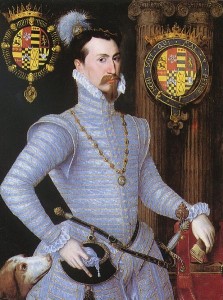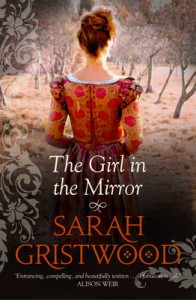What sparked your interest in Tudor history?
Probably the area in which I grew up – the south east corner of England, between Dover and Canterbury, where you really do feel yourself surrounded by history. That, and tv series like Elizabeth R, and Margaret Irwin’s trilogy of novels about that queen.
You have written a biography of Arbella Stuart. What makes her such a fascinating subject?
Firstly the fact that she had been neglected to an extraordinary degree – extraordinary, that is, for a girl who in her own day was expected to inherit Elizabeth I’s throne. Then I came across the amazing, self revelatory letters she wrote in 1603 – and then, as if that weren’t enough, there was her later story! Intrigue at James’s court, a secret marriage, escape abroad dressed as a man and imprisonment in the Tower – it’s got everything, really.
There are a number of books written about Elizabeth I and Robert Dudley, Earl of Leicester’s tumultuous relationship. Why did you feel it necessary to write another one?
At the time, there actually hadn’t been a non-fiction book about just that relationship for almost half a century – which meant that the last one had Elizabeth always being rescued from herself by ‘protective masculine authority’. There had been lots of fictional stories, but they seemed only to whet people’s appetites for the facts. Today’s generation of readers want to weigh the evidence for themselves – like any other historian, like Elizabeth and Robert’s contemporaries.
Why do you think that Elizabeth and Dudley’s relationship survived so many upheavals?
I think that for a woman so short of living blood relations, he became the nearest thing she had to family. I think, too, that she both used and depended on him in several different ways. He, of course, was motivated to stay close to her by self-interest – but also, I’d say, by real loyalty.
The Earl of Leicester is often portrayed as ambitious, self-serving, cruel and vain. He is even linked with the mysterious death of his first wife, Amy. In your opinion, was this the ‘real’ Leicester?
No, but that’s not to say he wasn’t ambitious, wasn’t vain – though there is no sign of cruel, and the evidence we have now suggests he didn’t murder Amy. But that ambition and vanity doesn’t mean he didn’t also care deeply about his queen. And his Protestant faith, and his country.
Finish this sentence, from her mother Elizabeth I inherited… her intelligence, her ability to seduce (not necessarily in a sexual way). And her mother’s death surely had a profound effect on Elizabeth’s later attitudes, especially in her reluctance to marry.
Could you share with us a little about your latest book, The Girl in the Mirror?
It’s my first historical novel – but related to my factual books, and particularly to Elizabeth and Leicester, in many ways. The central character is an invented one – Jeanne, a young Huguenot refugee who finds work in the household of Robert Cecil, and gets caught up in the intrigues and uncertainties of London in the 1590s. But the background is the relationship of Elizabeth and Essex – one which, I feel, non-fiction books have never quite been able to handle in a wholly satisfactory way.
I’m sure that you’ve visited many places connected to the Tudors. Do you have a favourite Tudor location?
I can’t choose just one! Can I have three? Hardwick Hall in Derbyshire where the dramas of Arbella Stuart’s life were acted out and which is preserved in its original state to an extraordinary degree. Hatfield House in Hertfordshire, Robert Cecil’s home – the main building is technically early Jacobean rather than Tudor, but the gardens helped to inspire The Girl in the Mirror and this is where Elizabeth heard the news of her accession. And at least one of the houses from Kent where I live – probably Penshurst Place, the family home of the Sidneys. Though it seems a pity to leave out Anne Boleyn’s home of Hever, just a few miles away . . .
What is the most interesting or peculiar fact you’ve learnt about the Tudors in your research?
I think what grips me most is their peculiar modernity – the fact that political spin, in particular, is not an invention of our own day.
I enjoy hearing from people of the past in their own words. Letters and journals reveal so much about the writer and the time in which they lived. Do you have a favourite historical quote?
It would be one from Arbella – ‘I must shape my own coat according to my cloth, but it will not be after the fashion of this world but fit for me.’
To learn more about Sarah Gristwood visit her official website here.




















Thanks for a great interview! I think Arbella’s story is amazing, too. And who can resist the longevitiy of Elizabeth and her Sweet Robin. May I recommend a new one (fiction) by Jeanne Westin, His Last Letter. Lovely book. Thanks!
Yes, Arbella’s story is fascinating! I have indeed read and reviewed ‘His Last Letter’ and had the pleasure of interviewing Jeanne. To say that I LOVED the book is an understatement!
Thank you for this interview! I recently bought a copy of Ms. Gristwood’s book on Arbella Stuart while visiting Hardwick Hall (about which I agree with her wholeheartedly). Now I must find a copy of The Girl in the Mirror.
Katy – glad you enjoySarah’s writing. The Girl in the Mirror comes out in June…